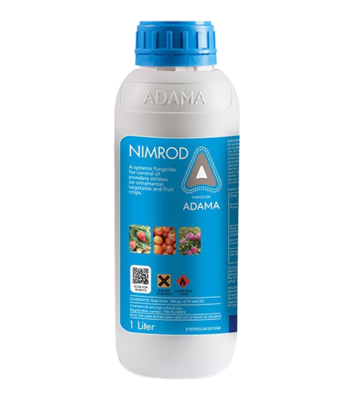Nimrod 250 EC
A systemic fungicide for the control of powdery mildew in ornamental, vegetable and fruit crops

General Info
Nimrod 250 EC is a systemic fungicide with tranlaminar and vapor action for control of powdery mildew on ornamental, vegetable and fruit crops.
Benefits for the Farmer
- Higher yields of crops
- Crops with higher quality
- A powerful tool to counter resistance development
- Safe and easy to use, with minimal effect on the environment
- Fast-acting and long-lasting
- Crop safety
- Safe at recommended dosage to all of the registered crops
- Rain fastness
WHO CLASS III
Application Advice
Preparation of Spray Mixture
Ensure that the sprayer is clean and calibrated to give even application, at the required volume. Half fill the spray tank with clean water, shake the Nimrod 250 EC container and add the required amount to the spray tank. Mix or agitate the spray solution after filling the spray tank. Continue agitaion during the spray process.
Compatibility
Nimrod 250 EC is compatible with most commonly used pesticides and foliar fertilizers. Do not mix Nimrod 250 EC with other chemicals when applying on cucumber.
Application Rates and Timing
|
Crop |
Application rate |
Application timing |
Pre-harvest interval |
|
Roses |
300 ml per 100 L of water or 3.0 L in 1000 L of water per Ha when disease is present 250 ml per 1000 L of water or 2.5 L in 1000 L of water per Ha when disease condition is expected |
Every 14 days. Apply before or at onset of disease signs |
Wait until the spray dries up. |
|
Peas and other vegetables |
700 ml per 300 L of water per Ha |
Every 7 days. Begin when disease signs are seen |
2 days |
|
Cucurbits |
200 ml per 1000 L of water |
Every 14 days (max 6 sprays) |
2 days |
|
Strawberries |
1.4 L in 500-600 L of water per Ha |
Every 10 days. Apply before blossom (max 3 sprays) |
1 day |
Safety
Re-entry interval: sprayed greenhouse or crop field can be re-entered after the spray has dried.
Nimrod 250 EC is moderately toxic to fish. Do not contaminate inters, dams and ponds with chemical or empty containers. Although Nimrod 250 EC has low toxicity to bees, avoid spraying on crops when foraging bees are busy.
HAZARDS/PRECAUTIONS
Handling
Wear protective clothing: hand gloves, face-shield, and impermeable boots whan preparing the spray mixture and spraying. Avoid contact with skin, eyes and clothing, inhalation of concentrated vapour and breathing the spray mist. Do not apply upwind and stay out of spray mist. Do not smoke, drink or eat while handling the product.
After Work
Wash hands and face with soap and water thoroughly. Change contaminated clothes and wash them. Clean the spray equipment carefully.
Storage
Store in original tightly closed container, in a cool dry dark place out of reach of children, away from food, drinks, animal feed, heat sparks and open flame.
Disposal
Dispose of empty rinsed container by crushing, cutting, then burning or burying (or use other approved local disposal procedures). Do not re-use empty containers for any other purpose. Pesticide spray mixture or rinsate that cannot be used must be disposed by spraying off on wasteland (or use other approved local disposal procedures).
FIRST AID INSTRUCTIONS
If Inhaled: Remove the patient from exposure, keep warm and at rest then seek medical attention.
If in contact with skin: Take off all contaminated clothes immediately and wash the skin with plenty of water and soap.
If in contact with eye: Wash out with clean water or eyewash for 15 minutes, then see the doctor.
If swallowed: Do not induce vomiting, as solvents may damage lungs.Take the patient and this label to the doctor at once.